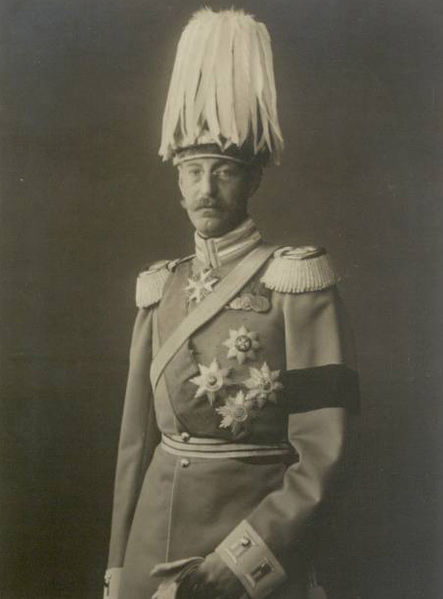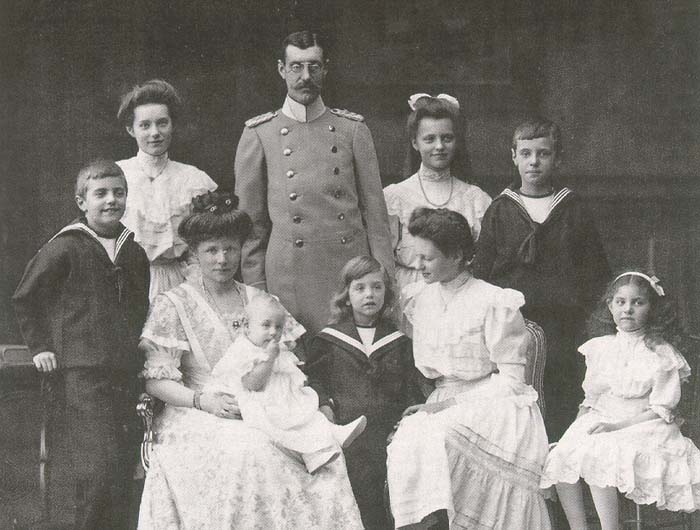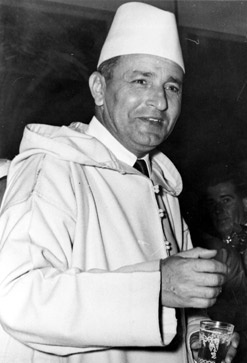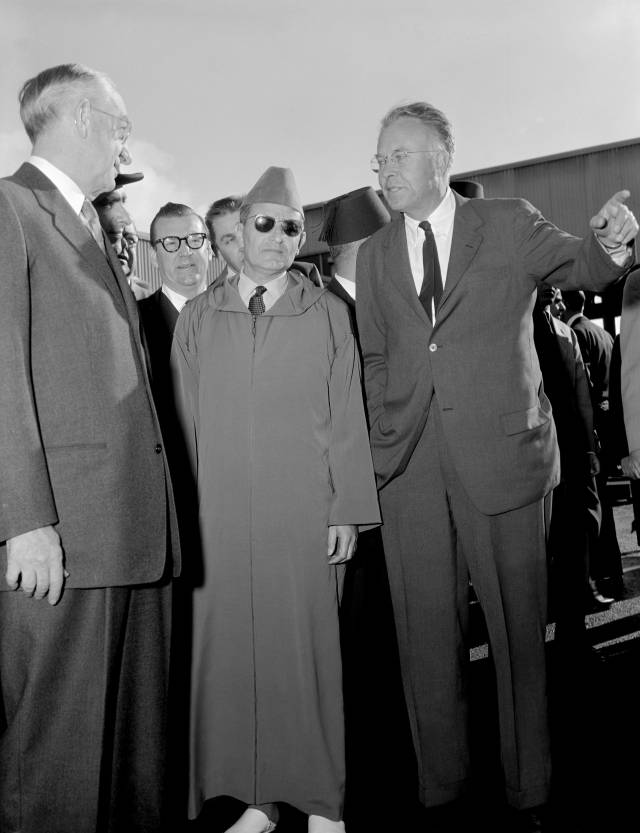<Back to Index>
- King of Lithuania Mindaugas II, 1864
- King of Morocco Mohammed V, 1909
PAGE SPONSOR


Prince Wilhelm of Urach, Count of Württemberg, 2nd Duke of Urach (Wilhelm Karl Florestan Gero Crescentius; German Fürst Wilhelm von Urach, Graf von Württemberg, 2.Herzog von Urach; 30 May 1864 – 24 March 1928) was a German prince who was elected King of Lithuania with the regnal name Mindaugas II on 11 July 1918. He never assumed the crown however, as German authorities declared the election invalid and the invitation was withdrawn in November 1918. From 17 July 1869 until his death he was head of the morganatic Urach branch of the House of Württemberg.
Born as HSH Prince Wilhelm Karl Florestan Gero Crescentius of Urach, Count of Württemberg, he was the elder son of Wilhelm, 1st Duke of Urach (the head of a morganatic branch of the Royal House of the then Kingdom of Württemberg), and his second wife, Princess Florestine of Monaco, occasional acting Regent of Monaco (daughter of Prince Florestan I of Monaco).
At the age of four Wilhelm succeeded his father as Duke of Urach. He was born and spent much of his childhood in Monaco, where his mother Florestine often managed the government while her nephew, Prince Albert I of Monaco, went on long oceanographic explorations. Wilhelm was culturally francophone.
Through his mother, Wilhelm was the legitimate heir to the throne of Monaco. Wilhelm's cousin Prince Albert I of Monaco had only one son Louis who was unmarried and had no legitimate children. The French Republic, however, was reluctant to see a German prince ruling Monaco. Under French pressure Monaco passed a law in 1911 recognizing Louis's illegitimate daughter, Charlotte, as heir; she was adopted in 1918 by her grandfather Prince Albert I. Wilhelm was relegated to third in line to Monaco's throne, behind Louis and Charlotte. Further, in July 1918 France and Monaco signed a treaty requiring that all future princes of Monaco must be French or Monegasque citizens, and must be approved by the French government. After the accession of Prince Louis II in 1922, Wilhelm renounced his rights of succession to the throne of Monaco in favor of distant French cousins, the counts of Chabrillan, in 1924.
In 1913 Wilhelm was one of several princes considered for the throne of Albania; he was supported by Catholic groups in the north. In 1914 Prince William of Wied was selected instead.
In 1917, as a newly retired general Wilhelm sounded out the possibility of being made Duke of Lorraine after
the war was over. In 1918 he accepted the short lived invitation to
reign as Mindaugas II of Lithuania. His claims were published in a 2001
essay by his grandson - in - law, Sergei von Cube.
Typical of his family, Wilhelm entered the army in 1883 and was a professional general by the outbreak of World War I in 1914, commanding the 26th Infantry Division. Until November 1914 they were part of the German assault on France and then Belgium, where Wilhelm's sister - in - law was queen. In December 1914 the division fought in the battle to cross the Bzura river in Poland. From June to September 1915 the division moved from north of Warsaw to positions close to the Neman River, an advance of hundreds of miles in the campaign in which Poland was taken. In October – November 1915 it took part in the assault on Serbia, moving from west of Belgrade to Kraljevo in less than a month. At Ypres in Belgium from December 1915 to July 1916, the division was largely destroyed in the Somme battles from August to November 1916, holding the Schwaben Redoubt (Swabia is part of Württemberg). Wilhelm retired as divisional general on 5 January 1917.
In 1917 - 18 he was "Kommandierender General" of 64th Corps (Generalkommando 64) on the western front; one of his aide de camps was Erwin Rommel.
On June 4, 1918 the Council of Lithuania voted to invite Wilhelm to become the king of a newly independent Lithuania. Wilhelm agreed and was elected on 11 July 1918, taking the name Mindaugas II. His election can be explained by several factors:
- he was Roman Catholic (the dominant religion in Lithuania);
- he was not a member of the House of Hohenzollern, the family to which belonged the German Emperor William II who wanted Lithuania to be a monarchy in personal union with Prussia;
- he had had a successful military career;
- if the Central Powers had won the war, Lithuania could have expected German protection in the event of future intrusions by Russia.
According to Wilhelm's agreement with the Council of Lithuania he had to live in Lithuania and speak its language.
From the beginning Wilhelm's reign was controversial. The four socialists of the twenty members of the Council of Lithuania left in protest. The German government did not recognize Wilhelm's selection as king, though the influential Mattias Erzberger supported the claim, being also a Catholic and from Württemberg. Wilhelm never had the chance to visit Lithuania, remaining instead at Lichtenstein Castle his home south of Stuttgart; however he started to learn the Lithuanian language. Within a few months of his election, it became clear that Germany would lose World War I, and on 2 November 1918, the Council of Lithuania reversed its decision.
In the tiny chapel of Lichtenstein Castle is a framed letter from Pope Benedict XV welcoming Wilhelm's selection as the future king of Lithuania.
In 2009 Wilhelm's grandson Inigo, the younger brother of the 5th duke, was interviewed on television in Vilnius, and said: "...if he was honored with a proposal to assume the throne of Lithuania, he would not refuse it."
The German anti - war novelist Arnold Zweig set his 1937 novel Einsetzung eines Königs (The Crowning of a King) around the election of Mindaugas in 1918.
Wilhelm was married twice. In 1892, he married Duchess Amalie in Bavaria (1865 – 1912), daughter of Karl - Theodor, Duke in Bavaria, a niece of Empress Elisabeth of Austria, and a direct descendant of the Lithuanian princess Louise Caroline Radvila of Biržai. Nine children were born of this marriage:
- Princess Marie Gabriele of Urach (1893 – 1908)
- Princess Elisabeth of Urach (1894 – 1962) who married Prince Karl of Liechtenstein (1878 – 1955), an uncle of Franz Joseph II of Liechtenstein, and had issue.
- Princess Karola of Urach (1896 – 1980)
- Prince Wilhelm of Urach (1897 – 1957), who morganatically married Elisabeth Theurer (1899 – 1988) and had two daughters, Elisabeth and Marie Christine, neither of whom married.
- Karl Gero, Duke of Urach (1899 – 1981), 3rd Duke, who married Countess Gabriele of Waldburg of Zeil and Trauchburg (1910 – 2005). No issue.
- Princess Margarete of Urach (1901 – 1975)
- Prince Albrecht of Urach (1903 – 1969). Married first Rosemary Blackadder and second Ute Waldschmidt. Divorced both of them and had issue by both. His daughter Marie - Gabrielle (aka Mariga) was the first wife of Desmond Guinness. A diplomat and artist turned journalist and expert on the Far East. His marriages were also considered morganatic but his descendants can claim titles that pass in the eldest female line.
- Prince Eberhard of Urach (1907 – 1969), who married Princess Iniga of Thurn and Taxis (1925 – 2008) and had issue; including Karl Anselm and Wilhelm Albert the current and 5th Duke of Urach. While a notional pretender to the crown of Lithuania, he has not made a formal public claim. Eberhard's descendants inherit the dukedom on the basis of the Salic law principle of Agnatic primogeniture
- Princess Mechtilde of Urach (1912 – 2001), who married Friedrich Karl, Prince of Hohenlohe - Waldenburg - Schillingsfürst and had issue.
Though Wilhelm's first wife had died in 1912, two of her ancestors had been elected to rule the Polish - Lithuanian Commonwealth in the 18th century; August III the Saxon and Stanisław Leszczyński. This may have been a contributory factor in his election as king of Lithuania.
In 1924, Wilhelm married Princess Wiltrud of Bavaria (1884 – 1975), daughter of King Ludwig III of Bavaria. This marriage was childless.
Prince Eberhard's son Inigo made a sentimental journey to Lithuania in November 2009, which was covered by the local media.
In 1921 the former king Wilhelm II of Württemberg died, without leaving a male heir. While the 2nd duke of Urach was technically the senior male descendant in the Württemberg royal family, it had already been decided that the succession would pass to his cousin Albrecht because of the morganatic marriage of the parents of the first duke of Urach.



Mohammed V (10 August 1909 – 26 February 1961) (Arabic: محمد الخامس) was Sultan of Morocco from 1927 – 53, exiled from 1953 – 55, where he was again recognized as Sultan upon his return, and King from 1957 to 1961. His full name was Sidi Mohammed ben Yusef, or Son of (Sultan) Yusef, upon whose death he succeeded to the throne. He was a member of the Alaouite Dynasty.
On 20 August 1953, the French who were occupying Morocco at the time forced Mohammed V and his family into exile on Corsica. A relative of his, Mohammed Ben Aarafa, was placed on the throne. Mohammed V and his family were then transferred to Madagascar in
January 1954. Mohammed V returned from exile on 16 November 1955, and
was again recognized as Sultan after active opposition to the French
protectorate.
In February 1956 he successfully negotiated with France for the independence of Morocco, and in 1957 took the title of King.
He died on 26 February 1961 following unspecified surgery. U.S. Ambassador Charles W. Yost saw the King hours before his death and was among those who suspected that the King's son, Hassan II, had a hand in his father's sudden death.
The Mohammed V International Airport of Casablanca is named after him, as well as numerous universities and various public spaces across Morocco. There is an Avenue Mohammed V in nearly every Moroccan city.
His first wife was Lalla Abla bint Tahar (Arabic: لالا عبلة بنت طهار) (born 5 September 1889 – died 1 March 1992), who was twenty years his senior. She was the daughter of Tahar ibn Hasan. She married Mohammed V in 1929 and died in Rabat on 1 March 1992, aged 102. She gave birth to five children: the future king Hassan II, Lalla Aicha (born 1930), Lala Malika, prince Abdallah and Lalla Nezha.
His second wife was Lalla Bint Mamoun. She was the mother of his second daughter Lalla Fatima Zohra.
His third wife was Lalla Bahia, mother of Lalla Amina.
In December 2007, The Forward reported on a secret diplomatic initiative by the Moroccan government to have Mohammed V admitted to the Righteous Among the Nations.